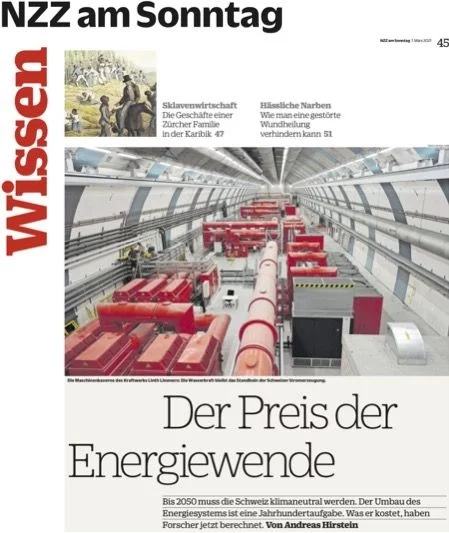The analysis was performed within the Swiss Competence Centre for Energy Research Joint Activity Scenarios and Modelling (SCCER JASM) by using the Swiss TIMES energy systems model (STEM) from 2017 to 2020. JASM was funded by InnoSuisse, and it was a joint activity of all eight SCCERs: Supply of Electricity, Efficient Technologies and Systems for Mobility, Heat and Electricity Storage, Biomass for Swiss Energy Future, Society and Transition, Efficiency of Industrial Processes, and Future Swiss Electrical Infrastructure. The JASM framework consisted of coupling energy-system and sectoral models to analyse net-zero emission scenarios for Switzerland. The research performed with STEM in SCCER JASM informed an NZZ am Sonntag article on the cost of the energy transition to net-zero emissions from the energy system by 2050, which was published on 7th March 2021. The SCCER JASM results were synthesised in a white paper published in 2021, and the STEM results are specifically published online at both the SCCER JASM and PSI websites and research journals.
The decarbonisation of the Swiss energy system by 2050 is technically possible. It requires scaling up clean technologies and efficiency in producing and using energy, with electricity, biofuels, hydrogen and e-fuels (Power-to-liquids and Power-to-gases) playing a key role in the future energy system fuel mix. Installation of solar PV capacity needs to double every decade from now until 2050; at least one in three new cars sold in 2030 needs to be electric; building renovations need to start almost immediately; the per capita final energy consumption needs to be slightly lower than the levels foreseen in the Swiss Energy Strategy targets. The electricity consumption increases by 11 TWh in 2050 from 2019; hydrogen use (also for domestic e-fuels production) raises to 11 TWhH2 in 2050; imported biofuels and zero-carbon e-fuels amount to 10 TWh in 2050; net imports of electricity in winter are about 6 TWh in 2050 (4 TWh on an annual basis). The introduction of low-carbon technologies based on new energy carriers requires the development of new distribution infrastructure and its efficient coupling, for example, between the electricity, gas and hydrogen grids, to reap economic benefits. Achieving net-zero emissions carbon capture is a prerequisite. About 8.6 Mt CO2 need to be captured in 2050, half of which are from bioenergy and direct air capture options (negative emission technologies). If storing CO2 in Switzerland is a challenge, access to international CO2 transport and storage infrastructure is essential to be developed.
Cost-efficient decarbonisation needs coordinated actions across four main pillars: a) exploitation of domestic renewable resources; b) high levels of integration between the Swiss and international energy markets; c) technology innovation and R&D to low-carbon technologies; d) deployment of CO2 capture in Switzerland and its storage either in Switzerland or abroad. The mitigation costs are surrounded by high uncertainty related to the developments in these four pillars. The core net-zero emissions scenario requires about 320 CHF/yr. and person from 2020 to 2050 (real prices of 2019) to finance the energy transition. In an extreme case of fragmented policies, low market integration, low domestic renewable resources and slow technical progress, the transition cost per capita can be three times higher than in the core net-zero scenario. In contrast, with positive developments in all these four pillars, the transition cost per capita can be 40% lower than in the core net-zero scenario.
The transition to net-zero emissions in 2050 entails challenges for all energy sectors. In buildings, targeted policies are needed to improve the payback time of renovation and remove the “split incentives” barrier between tenants and landlords. In industry, the timely replacement of ageing infrastructure with low-carbon alternatives needs to be supported, together with market designs encouraging consumption of low carbon intensity industrial products. In mobility, the momentum for electric vehicles needs to be amplified until other zero-carbon options also become available, e.g. hydrogen fuel cells. The electricity supply shifts to weather-driven production and the need for flexibility across all grid levels and from all actors of the energy system are increased. New fuels such as biofuels and hydrogen and new technologies such as Power-to-X and negative emissions technologies need strong and stable long-term signals to create demand, facilitate their deployment, and mitigate investment risks. Digitalisation and smart technology need to be integrated into the transition agenda to facilitate changes in consumer energy behaviour compatible with the decarbonisation targets.
Related to the highlight, an interview on the Energy transformation in Switzerland was provided: https://www.psi.ch/de/media/forschung/energiewende-der-schweiz
Contact
Evangelos Panos, Tom Kober, Laboratory for Energy systems Analysis, evangelos.panos@psi.ch
Original Publications
Final report: https://sccer-jasm.ch/JASMpapers/JASM_results_stem.pdf
and key finding and further downloadable modelling results available here:
https://www.psi.ch/en/eem/projects/sccer-joint-activity-scenarios-and-modelling

